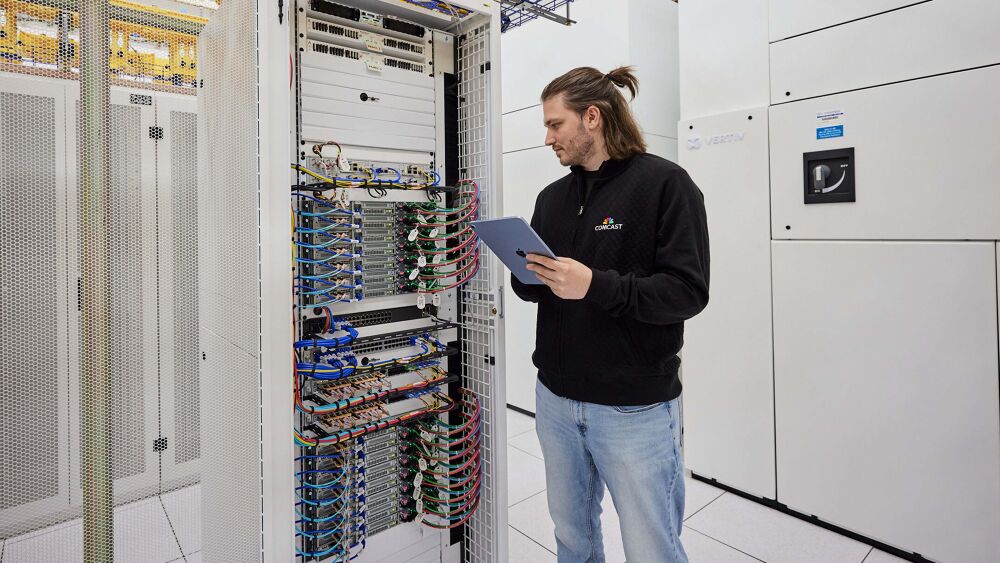Leaner, Greener Technology Supports 40% Energy Efficiency Gains for Comcast's Nationwide Network
Comcast has announced a significant reduction in the electricity required to deliver data across its network by 40% since 2019, owing to its shift to virtualized, cloud-based technologies. This network transformation enables faster broadband speeds and greater reliability with less equipment and energy usage, contributing to Comcast's goal of carbon neutrality by 2035. Electricity consumption per terabyte (TB) of data has decreased from 18.4 kWh in 2019 to 11.0 kWh in 2023. Collaborations with business partners like Hewlett Packard Enterprise are pivotal in this shift, promoting sustainable, energy-efficient innovations.
- 40% reduction in electricity consumption per byte since 2019.
- Decreased electricity usage from 18.4 kWh/TB in 2019 to 11.0 kWh/TB in 2023.
- Commitment to carbon neutrality by 2035 for Scope 1 and 2 emissions.
- Adoption of virtualized, cloud-based technologies for increased efficiency.
- Collaborations with partners like Hewlett Packard Enterprise to enhance energy efficiency.
- None.
Insights
Comcast's announcement of reducing electricity usage by
Short-term, investors might see modest financial benefits as the company reaps the rewards of lower energy costs. Long-term, the commitment to doubling network energy efficiency by 2030 and carbon neutrality by 2035 can foster increased investor confidence, potentially translating into
Comcast's shift to virtualized, cloud-based technologies is a significant technological advancement. The move towards an edge cloud infrastructure allows for reduced energy consumption as processing power is decentralized closer to the data source, minimizing latency and enhancing performance. This transition could set a new industry benchmark, influencing other network providers to adopt similar green technologies.
From a consumer perspective, this means more reliable and faster internet service with potentially fewer disruptions thanks to real-time performance visibility and self-healing capabilities. This technology shift could lead to Comcast gaining a competitive edge in the market.
However, one must consider the initial investment and integration challenges. While virtualized systems are more efficient, the cost and complexity of implementing such a transformation across a nationwide network are non-trivial. Yet, the long-term benefits in terms of energy savings, reduced operational costs and improved customer satisfaction seem to outweigh the initial hurdles.
Comcast's commitment to energy efficiency and sustainability can significantly influence its market positioning. In an era where consumers and investors increasingly prioritize corporate responsibility, Comcast's proactive steps toward carbon neutrality could enhance its brand image and customer loyalty. Moreover, partnerships with companies like Hewlett Packard Enterprise to implement energy-efficient solutions indicate a collaborative approach that can amplify these benefits through shared technology and innovation.
However, it is important to keep an eye on how these energy initiatives translate into market share and customer acquisition over time. While environmental initiatives are commendable, they must also align with consumer demand and willingness to support such initiatives potentially through higher-priced services if that becomes necessary. The balance between maintaining competitive pricing and investing in sustainable technology will be crucial.
PHILADELPHIA, PA / ACCESSWIRE / July 8, 2024 / Comcast announced it has reduced the electricity it takes to deliver each byte of data across its network by
The efficiency gains have been achieved through Comcast's ongoing nationwide network transformation to virtualized, cloud-based technologies that deliver faster broadband speeds and greater reliability with less equipment, less space, and less energy per byte.
"By moving more computing power to our edge cloud, we can leverage leaner, greener technology to process more customer traffic with less electricity," said Elad Nafshi, Executive Vice President and Chief Network Officer at Comcast.
These next-generation technologies will further drive efficiency through real-time performance visibility that can detect issues and self-heal - delivering a service that is better for both our customers and the planet.
ELAD NAFSHI
Executive Vice President and Chief Network Officer at Comcast
Comcast has a goal to be carbon neutral by 2035 for Scope 1 and 2 emissions across its global operations. With purchased electricity accounting for the majority of its emissions, Comcast is investing in clean, renewable energy to power its network and operations, as well as continuing to improve network energy efficiency.
Comcast decreased the electricity per consumed byte from 18.4 kilowatt-hours (kWh) per terabyte (TB) in 2019 to 11.0 kWh/TB in 2023.1
"We're proud of the progress we've achieved through Comcast innovation, but we're not stopping here," Nafshi added. "We're continuing to work with business partners to embed energy efficiency into future generations of technology so that we continue on the path to a greener, cleaner internet."
Comcast set a goal to double network energy efficiency by 2030, cutting the electricity per consumed byte of data in half.
Business partners like Hewlett Packard Enterprise are supporting Comcast's network transformation to a virtualized cable modem termination system (vCMTS) with new energy efficient technologies that deliver more network traffic at a fraction of the physical footprint and energy load of previous generation technologies.
"Our innovation with the HPE ProLiant DL110 drives network transformation with open, high-performance, energy-efficient solutions, and we're proud to have collaborated with Comcast to advance its initiatives and support its sustainability goals," said Phil Cutrone, Senior Vice President & General Manager, Service Providers, OEM, Telco, Major Accounts at Hewlett Packard Enterprise. "The collaboration demonstrates the impact across the value chain - from cutting the carbon footprint of technologies that drive the network, to improving the end customer experience."
For more information on Comcast's environmental efforts, visit the environment page at Comcast.com.
Forward-Looking Statements
This communication includes estimates, projections and statements regarding plans and goals that may constitute "forward-looking statements" within the meaning of the Private Securities Litigation Reform Act of 1995 and Section 21E of the Securities Exchange Act of 1934. For more information on these statements, please see https://corporate.comcast.com/impact/environment/forward-looking-statements.
1 Our 2023 electricity per consumed byte reporting reflects certain recalculations to prior years (2019 - 2022).

View additional multimedia and more ESG storytelling from Comcast Corporation on 3blmedia.com.
Contact Info:
Spokesperson: Comcast Corporation
Website: https://www.3blmedia.com/profiles/comcast-corporation
Email: info@3blmedia.com
SOURCE: Comcast Corporation
View the original press release on accesswire.com







